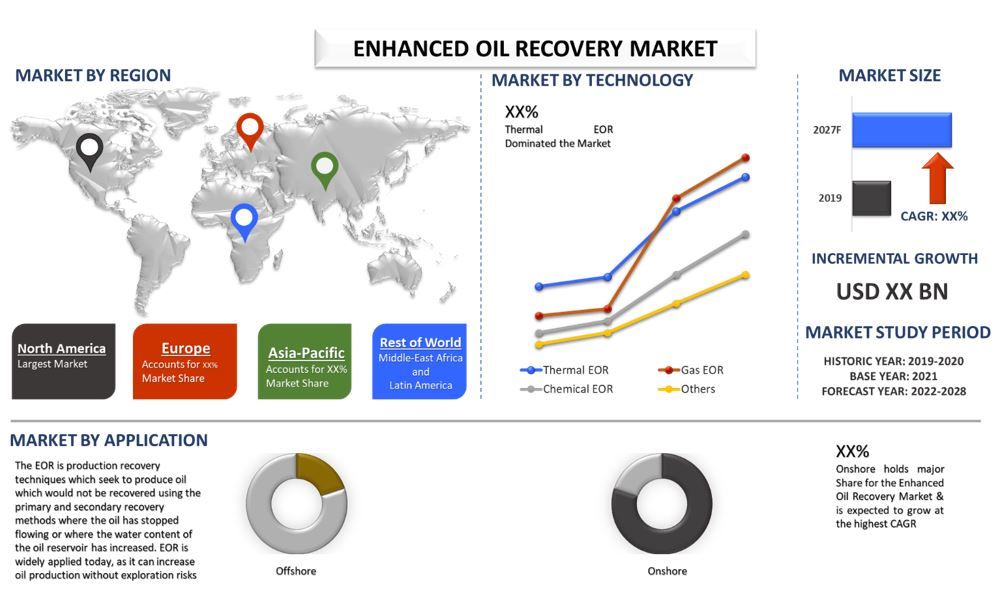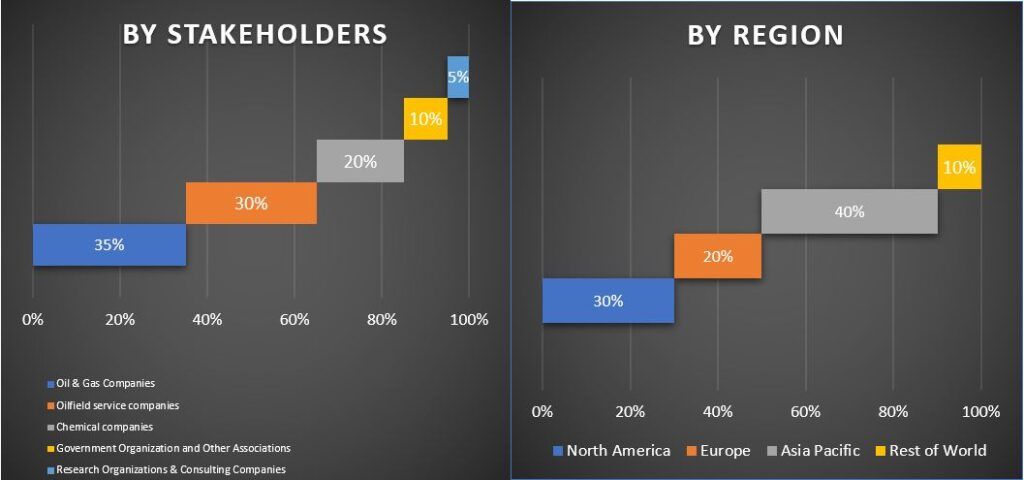Emphasis on Technology (Thermal EOR, Gas EOR, Chemical EOR, and Others); Application (Onshore and Offshore); Region and Country

Enhanced Oil Recovery Market was valued at US$ 40 billion in 2020 and is expected to grow at a CAGR of 6% over the forecast period (2021-2027). Enhanced oil recovery (EOR), also called tertiary recovery, is the extraction of crude oil from an oil field that cannot be extracted otherwise. EOR can extract 30% to 60% or more of a reservoir’s oil, compared to 20% to 40% using primary and secondary recovery. EOR can reverse the decline of mature fields and increase the overall percentage recovered. In some fields recovery rates greater than 60% have been achieved (e.g., Prudhoe Bay in Alaska). There are three main types of EOR, including chemical flooding, gas injection and thermal recovery. As per IEA, Historically EOR production has been concentrated in North America, but in recent years other countries have started deploying EOR technologies. Malaysia has started offshore EOR production, while the United Arab Emirates, Kuwait, Saudi Arabia, India, Colombia, and Ecuador have all started pilot EOR projects. Also, it estimated about 375 enhanced oil recovery projects worldwide produced slightly more than 2 million b/d in 2018. They forecasted this could grow to 4.5 million b/d, or around 4% of world production, by 2040.
The Global Enhanced Oil Recovery Market is experiencing significant growth due to upsurge in the number of aged wells, continuous unconventional gas production activities such as shale gas & increase in global demand for oil are the key factors complementing the Enhanced Oil Recovery market.
Halliburton, Schlumberger Limited, Royal Dutch Shell Plc, BP Plc, Air Liquide S.A. etc. are some of the prominent players operating in the Global Enhanced Oil Recovery Market. Several M&As along with partnerships have been undertaken by these players to facilitate countries with more innovative Enhanced Oil Recovery techniques.
Insights Presented in the Report
“Amongst technology, Thermal EOR segment holds the major share.”
Based on technology, the market is segmented into Thermal EOR, Gas EOR, Chemical EOR, and others. The Thermal EOR segment grabbed XX% market share of the Global Enhanced Oil Recovery Market and gathered revenue of USD XX billion in 2020. The segment is expected to grow at a CAGR of XX% during the forecast period to reach a market valuation of USD XX billion by 2027 owing to its ability to lower the viscosity, or thin, the heavy viscous oil, and improve its ability to flow through the reservoir. However, Gas EOR driven by CO2 injection technology will grow at the fastest rate due to increasing focus on unconventional gas production across the globe.
“Amongst Application, Onshore dominated the market in 2020.”
Based on Application, the market is classified into Onshore, and Offshore. The Onshore segment generated revenue of USD XX billion in 2020. The segment is expected to grow at a CAGR of XX% during the forecast period to reach a market valuation of USD XX billion by 2027 owing to the presence of several onshore exploration and production projects across the world.
“North America represents as the largest market in the Global Enhanced Oil Recovery Market.”
For a better understanding of the market adoption of Enhanced Oil Recovery, the market is analyzed based on its worldwide presence in the countries such as North America (United States, Canada, Rest of North America), Europe (Germany, France, Italy, Spain, United Kingdom, and Rest of Europe), Asia-Pacific (China, Japan, India, Australia, and Rest of APAC), MEA, and Rest of World. North America constitutes the largest market for the industry and generated revenue of USD XX billion in 2020 on account of presence of several unconventional oil and gas resources and matured fields in the region. However, Asia Pacific is poised to grow at the fastest rate due to rising oil and gas demand from the major economies including China and India along with the increased deployment of EOR in aged wells.
Reasons to buy this report:
Customization Options:
The Global Enhanced Oil Recovery Market can further be customized as per the requirement or any other market segment. Besides this, UMI understands that you may have your own business needs, hence feel free to connect with us to get a report that completely suits your requirements.
1. Market Introduction
2. Research Methodology Or Assumption
3. Market Synopsis
4. Executive Summary
5. Global Enhanced Oil Recovery Market Covid-19
6. Global Enhanced Oil Recovery Market Revenue (usd Bn), 2019-2027f
7. Market Insights By Technology
8. Market Insights By Application
9. Market Insights By Region
10. Enhanced Oil Recovery Market Dynamics
11. Enhanced Oil Recovery Market Opportunities
12. Enhanced Oil Recovery Market Trends
13. Legal & Regulatory Framework
14. Demand And Supply Side Analysis
15. Value Chain Analysis
16. Competitive Scenario
17. Company Profiled
18. Disclaimer
Analyzing the historical market, estimation of the current market, and forecasting the future of the Global Enhanced Oil Recovery were the three major steps undertaken to create and analyze the adoption of Enhanced Oil Recovery across various segments in North America, Europe, Asia Pacific, MEA, & Rest of the world. Exhaustive secondary research was conducted to collect the historical market numbers and estimate the current market size. Secondly, to validate these insights, numerous findings and assumptions were taken into consideration. Moreover, exhaustive primary interviews were also conducted, with industry experts across the value chain of the Enhanced Oil Recovery sector. Post assumption and validation of market numbers through primary interviews, we employed a bottom-up approach to forecast the complete market size. Thereafter, market breakdown and data triangulation methods were adopted to estimate and analyze the market size of segments and sub-segments the industry pertains to. Detailed methodology is explained below:
Analysis of Historical Market Size
Step 1: In-Depth Study of Secondary Sources:
Detailed secondary study was conducted to obtain the historical market size of the Enhanced Oil Recovery through company internal sources such as annual report & financial statements, performance presentations, press releases, etc., and external sources including journals, news & articles, government publications, competitor publications, sector reports, third-party database, and other credible publications.
Step 2: Market Segmentation:
After obtaining the historical market size of the Enhanced Oil Recovery Market, we conducted a detailed secondary analysis to gather historical market insights and share for different segments & sub-segments for major regions. Major segments included in the report are as technology, and application. Further regional & country-level analyses were conducted to evaluate the overall adoption of the Enhanced Oil Recovery in the global context.
Step 3: Factor Analysis:
After acquiring the historical market size of different segments and sub-segments, we conducted a detailed factor analysis to estimate the current market size of Enhanced Oil Recovery. Further, we conducted factor analysis using dependent and independent variables like an increasing number of aged wells and the need for advanced technologies like Enhanced Oil Recovery. Historical trends and their year-on-year impact on the market size and share in the recent past was analyzed. Demand and supply side scenario was also thoroughly studied.
Current Market Size Estimate & Forecast
Current Market Sizing: Based on actionable insights from the above 3 steps, we arrived at the current market size, key players in the Global Enhanced Oil Recovery Market, and market shares of the segments. All the required percentage split, and market breakdowns were determined using the above-mentioned secondary approach and were verified through primary interviews.
Estimation & Forecasting: For market estimation and forecast, weights were assigned to different factors including drivers & trends, restraints, and opportunities available for the stakeholders. After analyzing these factors, relevant forecasting techniques i.e., bottom-up approach was applied to arrive at the market forecast to 2027 for different segments and subsegments across the major regions globally. The research methodology adopted to estimate the market size encompasses:
Market Size and Share Validation
Primary Research: In-depth interviews were conducted with the Key Opinion Leaders (KOLs) including Top Level Executives (CXO/VPs, Sales Head, Marketing Head, Operational Head, and Regional Head, Country Head, etc.) across major countries. Primary research findings were then summarized, and statistical analysis was performed to prove the stated hypothesis. Inputs from primary research were consolidated with secondary findings, hence turning information into actionable insights.
Split of Primary Participants in Different Regions

Market Engineering
Data triangulation technique was employed to complete the overall market estimation and to arrive at precise statistical numbers of each segment and sub-segment of the Global Enhanced Oil Recovery Market. Data was split into several segments & sub-segments post studying various parameters and trends in the areas of technology, and application verticals.
The main objective of the Enhanced Oil Recovery Market Study
The current & future market trends of Enhanced Oil Recovery were pinpointed in the study. Investors can gain strategic insights to base their discretion for investments from the qualitative and quantitative analysis performed in the study. Current and future market trends determine the overall attractiveness of the market at a global & country level, providing a platform for the industrial participant to exploit the untapped market to benefit as a first-mover advantage. Other quantitative goals of the studies include:
Customers who bought this item also bought